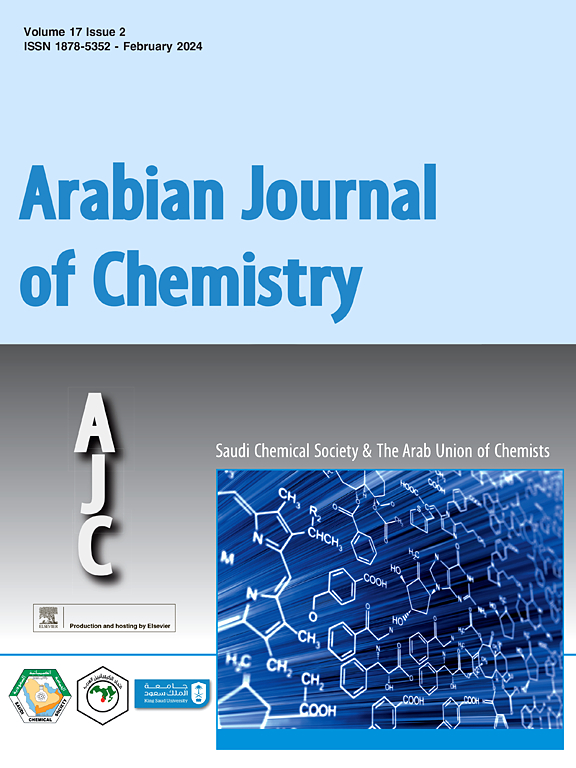改性硅胶支撑银纳米粒子的制备及其用于水消毒的抑菌区评估
IF 5.2
2区 化学
Q2 CHEMISTRY, MULTIDISCIPLINARY
引用次数: 0
摘要
在这项工作中,研究了改性硅胶支撑银纳米粒子的制备,并利用抑制区对其进行了水消毒评估。茶秸秆 [TS] 和茶秸秆灰 [TSA] 的二氧化硅含量分别为 5.92 % 和 92.21 %。在 700 °C 下煅烧的 TS 灰与 NaOH 溶液混合。然后用盐酸溶液中和溶液,再用溶胶凝胶法形成凝胶。硅胶产量被记录下来并进行了表征。在 700 °C 的煅烧温度下,硅胶具有主要的二氧化硅官能团、无定形结构、高孔隙率形态、高表面积(807.163 m2/g)、孔体积(0.34 cm3/g)、孔直径(1.70 nm)和纯度(99.39 %)。然后,使用不同体积比的三甲基氯硅烷(TMCS)/乙醇/正己烷对其进行进一步改性,得到改性硅胶(MSG)。MSG 具有水处理过程中所需的优异疏水性能。在该方法中,TMCS 改性剂使 MSG 具有主要的二氧化硅官能团和良好的有序结构,TMCS/乙醇/己烷的体积比分别为 0.25:0.25:1 时,MSG 的最大表面积为 510.40 m2/g。然后,将不同浓度的 AgNPs-MSG 混合,制备出 MSG 支持的 AgNPs(MSG-AgNPs),并对其进行了表征。在 1.5 mM 的 AgNPs 浓度下,MSG-AgNPs 的最大比表面积为 475.0 m2/g。利用抑菌区测量和批量消毒研究评估了味精-AgNPs 对大肠杆菌和金黄色葡萄球菌的性能。在初始细菌浓度为 1.5 x 108 CFU/mL 时,大肠杆菌和金黄色葡萄球菌的最大抑菌区直径分别为 12.80 毫米和 14.30 毫米。本文章由计算机程序翻译,如有差异,请以英文原文为准。
Preparation of modified silica gel supported silver nanoparticles and its evaluation using zone of inhibition for water disinfection
In this work, preparation of modified silica gel supported silver nanoparticles and its evaluation using zone of inhibition for water disinfection were investigated. The silica contents of the teff straw [TS] and teff straw ash [TSA] are 5.92 and 92.21 %, respectively. The calcinated TS ash at 700 °C was mixed with NaOH solution. The solution is then neutralized with HCl solution and then gel formation using the sol gel method. The silica gel yield was recorded and characterized. The SG with major silica functional group, amorphous structure, high porosity from the morphology, high surface area of 807.163 m2/g, pore volume of 0.34 cm3/g, pore diameter of 1.70 nm and silica gel purity of 99.39 % were achieved at a calcination temperature of 700 °C. It is then; further modified using trimethylchlorosilane (TMCS)/ethanol/hexane at different volumetric ratio and the resulting product is modified silica gel (MSG). MSG has excellent hydrophobic properties that have been required during water treatment. In this method, MSG with a major silica functional group, well ordered structure due to the TMCS modifier, maximum surface area of 510.40 m2/g was achieved at volumetric ratio of 0.25:0.25:1 of TMCS/ethanol/hexane, respectively. Then, MSG supported AgNPs (MSG-AgNPs) was prepared by mixing different concentrations of AgNPs-MSG and characterized. The MSG-AgNPs have shown AgNPs on the surface of MSG from the EDX result, different absorbance, pore from the morphology, with a maximum surface area of 475.0 m2/g was obtained at 1.5 mM of AgNPs concentrations. The performance of MSG-AgNPs was evaluated using zone of inhibition measurement and batch disinfection studies against E. coli and S. aureus. At 1.5 x 108 CFU/mL initial bacterial concentrations, the maximum inhibition zone diameter was 12.80 and 14.30 mm for E. coli and S. aureus, respectively.
求助全文
通过发布文献求助,成功后即可免费获取论文全文。
去求助
来源期刊

Arabian Journal of Chemistry
CHEMISTRY, MULTIDISCIPLINARY-
CiteScore
10.80
自引率
3.30%
发文量
763
审稿时长
63 days
期刊介绍:
The Arabian Journal of Chemistry is an English language, peer-reviewed scholarly publication in the area of chemistry. The Arabian Journal of Chemistry publishes original papers, reviews and short reports on, but not limited to: inorganic, physical, organic, analytical and biochemistry.
The Arabian Journal of Chemistry is issued by the Arab Union of Chemists and is published by King Saud University together with the Saudi Chemical Society in collaboration with Elsevier and is edited by an international group of eminent researchers.
 求助内容:
求助内容: 应助结果提醒方式:
应助结果提醒方式:


